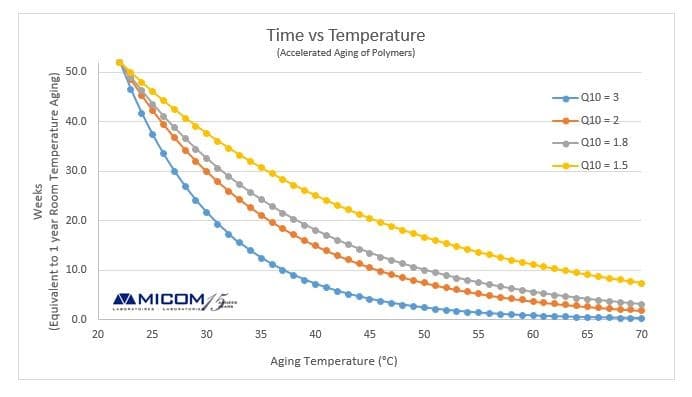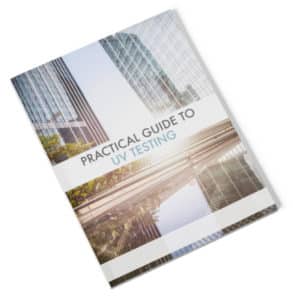Accelerated Aging Testing
Accelerated aging test services are offered at Micom Laboratories to a wide range of industries. Essentially, most of what we do answers one of the three following questions:
- What happened to my product/material/assembly?
- What will happen to my product/material/assembly?
- How strong is my product/material/assembly?
What is accelerated aging used for?
Accelerated aging is used to simulate real-time aging under controlled, yet accelerated conditions. Aging methods use one or more of the following aging processes: heat, cold, humidity, sunlight, vibrations, corrosive environment, cyclical loads and many more. In many cases, more than one of the aging processes is applied simultaneously.
How We Accelerate A Product’s Aging Process
A product’s aging process can be accelerated in the laboratory in various ways depending on the material/product being tested, the intended use, and the ambient conditions while the material/product is in use. Below are the various Accelerated Aging processes Micom offers:
When doing this type of testing, it is important to understand the product characteristics, the normal use conditions, what constitutes foreseeable abuse, and the product’s life expectancy. In all cases, our customers want to have their answers yesterday. However, to have a good test plan one must be careful not to expose the product to be tested to conditions that are such that abnormal aging processes start occurring.
Basic Rules
Increased temperatures are often by themselves but often in conjunction with other accelerated aging processes (humidity, UV, electrolytes/salt solutions (corrosion)). Indeed, heat often works synergistically with other aging processes.
Temperature
Nonetheless, there are some basic rules to be followed in all aging test procedures. Except for freeze-thaw cycles that assesses the impacts of phase changes, all aging processes increase as a function of the ambient temperature. This acceleration process is governed by Arrhenius’s equation:
![]()
Where:
TAA: Accelerated aging temperature (oC)
TRT: Ambient temperature (oC)
Q10: Rate of the chemical reaction, typically 2
In layman’s terms, any chemical reaction will double its rate with each 10 °C increase. This is why corrosion and UV aging, for example, are both done at temperatures above room temperature. Conversely, excessive temperature exposure is not recommended. Indeed, beyond a certain point, the molecules of a given material can be supplied with sufficiently high levels of activation energy that will allow them to create some chemical reactions that would not naturally occur even over long periods of time or extremely adverse conditions. Furthermore, in many accelerated aging processes, there is an asymptotic behavior for organic molecules i.e.: beyond a certain temperature there is no significant gain; only risk.
Arrhenius’s law is general in nature, and it assumes the general case where the aging rate doubles every 10oC increase. This ideal case would correspond to curve Q10=2 above. Should this be the case, and should you wish to age your products at a temperature of 45 oC, you would need a 10-week aging process to simulate one year of real-life aging. The accelerated aging factor is not always “2”. If the aging factor is known, then the simulation can be adjusted accordingly. For example, should it turn out that the material being tested has an accelerated aging factor of 3 (q10=3 above); for the same aging temperature of 45 oC, the number of normal use weeks of aging would be 4 instead of 10.
Heat aging is often done to ASTM D3035 and ASTM F1980.

What is accelerated aging in medical devices?
Accelerated aging testing for medical devices is used to simulate real-time on an accelerated basis. ASTM F1980 is one of the many standards we use for Accelerated Aging of Sterile Barrier Systems for Medical Devices as well as for components. There are many aging techniques that must be used and sometimes combined to simulate the various stresses a medical device will endure from “cradle to grave”.
Accelerated temperature aging is typically done at 65°C although lower temperatures must sometimes be used. The lower the temperature, the lower the accelerated aging factor is and the longer the aging process takes. 65°C is a temperature often used for heat aging. At this temperature, a 3-4 week exposure is equivalent to one year of storage under normal (23°C) conditions.
The most recent version of ASTM F1980 (2021) requires relative humidity to be added in the aging process as for some thermodegradation chemical aging reactions to occur, water must be present (e.g.: polyamide degradation). However, no relative humidity level is specified in the test method. Furthermore, as we increase temperature through the aging process, the ambient relative humidity automatically goes down which could also end up drying up the polymers and induce degradations that would not normally occur in real-time aging conditions.
Having to control relative humidity while testing as per ASTM F1980 and other similar test methods mandates the use of climatic chambers instead of lab ovens. This unfortunately makes the testing more expensive as the equipment is far more sophisticated.
Other tests related to the medical device in accelerated aging:
- Climatic chamber – Humidity, temperature cycling -78oC to +150oC, 10 – 95% RH
- UV testing – ASTM G155, ASTM G154, ISO 4892
- Salt sprays – ASTM B117, ISO 7253, ASTM D1735, ASTM D2247, ASTM D5894, ASTM G85
- Heat aging testing – ISO 2578
- Laboratory simulations of field failures
- Thermal shock testing (-78oC to +200oC)
- HASS/HALT
- High & low temperature tensile & compression tests
Complementary Material Testing
In many cases, once the aging process has been completed, physical/mechanical measurements need to be made on the samples to assess if whether or not product properties were modified; Micom offers a whole host of mechanical, physical and physic-chemical tests to quantify the changes in the product/material properties.
For more post-test evaluation test methods; please see: ASTM Testing and Coating Testing.
Should you need help, our experts will be happy to recommend proper test conditions addressing your specific concerns and needs; call us @ 1-888-996-4266 or contact us today.


 A free eBook to help you better safeguard your products from UV damage.
A free eBook to help you better safeguard your products from UV damage.